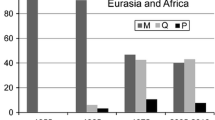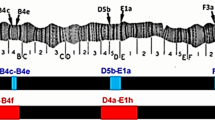Abstract
The I factor is a transposable element controlling the I-R system of hybrid dysgenesis in Drosophila melanogaster. This phenomenon occurs when males from the inducer class of strains are crossed with females from the reactive class of strains1. Inducer strains contain complete 5.4-kilobase (kb) I factors, reactive strains do not2,3. Incomplete I elements are present in peri-centromeric regions of both categories of strains2. The 5.4-kb I factors are genetically active in stimulating hybrid dysgenesis and can transpose, whereas incomplete I elements seem to be genetically inactive and transpose rarely. The results of in situ hybridization and Southern transfer experiments indicate that most incomplete I elements are at constant locations in all D. melanogaster populations, suggesting that they were present in the genome before the spread of this species throughout the world. To investigate the evolutionary origin of the I factor, we have studied various Drosophila species for the presence of sequences homologous to it. We find that such sequences are widespread. Moreover, elements that are very similar to complete and active I factors occur in the species most closely related to D. melanogaster.
Similar content being viewed by others
References
Bregliano, J. C. & Kidwell, M. G. in Mobile Genetic Elements (ed. Shapiro, J.) 363–410 (Academic, New York, 1983).
Bucheton, A., Paro, R., Sang, H. M., Pélisson, A. & Finnegan, D. J. Cell 38, 153–163 (1984).
Finnegan, D. J. & Fawcett, D. H. in Oxford Surveys on Eucaryotic Genes Vol. 3 (Oxford University Press, in the press).
Throckmorton, L. H. in Handbook of Genetics Vol. 3 (ed. King, R. C.) 421–469 (Plenum, New York, 1975).
Lemeunier, F., David, J., Tsacas, L & Ashburner, M. in The Genetics and Biology of Drosophila Vol. 3e (eds Ashburner, M., Carson, H. L. & Thompson, J. N.) (Academic, London, in the press).
Kidwell, M. G. Proc. natn. Acad. Sci. U.S.A. 80, 1655–1659 (1983).
Kidwell, M. G., Frydryk, T. & Novy, J. B. Drosoph. Inf. Serv. 59, 63–69 (1983).
Engels, W. R., A. Rev. Genet. 17, 315–344 (1983).
O'Hare, K. Trends Genet. 1, 250–254 (1985).
Brookfield, J. F. Y., Montgomery, E. & Langley, C. H. Nature 310, 330–332 (1984).
Daniels, S. B., Strausbaugh, L. D., Ehrman, L. & Armstrong, R. Proc. natn. Acad. Sci. U.S.A. 81, 6794–6797 (1984).
Anxolabehere, D., Nouaud, D. & Périquet, G. Genet. Select. Evol. 17, 579–584 (1985).
Lansman, R. A., Stacey, S. N., Grigliatti, T. A. & Brock, H. W. Nature 318, 561–563 (1985).
Southern, E. M. J. molec. Biol. 98, 503–517 (1975).
Rigby, P. W., Dieckmann, M., Rhodes, C. & Berg, P. J. J. molec. Biol. 113, 237–251 (1977).
Author information
Authors and Affiliations
Rights and permissions
About this article
Cite this article
Bucheton, A., Simonelig, M., Vaury, C. et al. Sequences similar to the I transposable element involved in I-R hybrid dysgenesis in D. melanogaster occur in other Drosophila species. Nature 322, 650–652 (1986). https://doi.org/10.1038/322650a0
Received:
Accepted:
Issue Date:
DOI: https://doi.org/10.1038/322650a0
- Springer Nature Limited
This article is cited by
-
Whole genome sequencing in Drosophila virilis identifies Polyphemus, a recently activated Tc1-like transposon with a possible role in hybrid dysgenesis
Mobile DNA (2014)
-
Evolutionary conservation and molecular characteristics of repetitive sequences of Drosophila koepferae
Heredity (1996)
-
Evolution of the LINE-like I element in the Drosophila melanogaster species subgroup
Molecular and General Genetics MGG (1995)
-
I factors inDrosophila melanogaster: Transposition under control
Genetica (1994)
-
Mosquito transposable elements
Genetica (1994)





